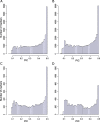Genomic analysis of Spanish wheat landraces reveals their variability and potential for breeding
- PMID: 32019507
- PMCID: PMC7001277
- DOI: 10.1186/s12864-020-6536-x
Genomic analysis of Spanish wheat landraces reveals their variability and potential for breeding
Abstract
Background: One of the main goals of the plant breeding in the twenty-first century is the development of crop cultivars that can maintain current yields in unfavorable environments. Landraces that have been grown under varying local conditions include genetic diversity that will be essential to achieve this objective. The Center of Plant Genetic Resources of the Spanish Institute for Agriculture Research maintains a broad collection of wheat landraces. These accessions, which are locally adapted to diverse eco-climatic conditions, represent highly valuable materials for breeding. However, their efficient use requires an exhaustive genetic characterization. The overall aim of this study was to assess the diversity and population structure of a selected set of 380 Spanish landraces and 52 reference varieties of bread and durum wheat by high-throughput genotyping.
Results: The DArTseq GBS approach generated 10 K SNPs and 40 K high-quality DArT markers, which were located against the currently available bread and durum wheat reference genomes. The markers with known locations were distributed across all chromosomes with relatively well-balanced genome-wide coverage. The genetic analysis showed that the Spanish wheat landraces were clustered in different groups, thus representing genetic pools providing a range of allelic variation. The subspecies had a major impact on the population structure of the durum wheat landraces, with three distinct clusters that corresponded to subsp. durum, turgidum and dicoccon being identified. The population structure of bread wheat landraces was mainly biased by geographic origin.
Conclusions: The results showed broader genetic diversity in the landraces compared to a reference set that included commercial varieties, and higher divergence between the landraces and the reference set in durum wheat than in bread wheat. The analyses revealed genomic regions whose patterns of variation were markedly different in the landraces and reference varieties, indicating loci that have been under selection during crop improvement, which could help to target breeding efforts. The results obtained from this work will provide a basis for future genome-wide association studies.
Keywords: DArTseq markers; GBS; Genetic diversity; Local germplasm; Population structure; SNP; Wheat improvement.
Conflict of interest statement
The authors declare that they have no competing interests.
Figures







Similar articles
-
High-density molecular characterization and association mapping in Ethiopian durum wheat landraces reveals high diversity and potential for wheat breeding.Plant Biotechnol J. 2016 Sep;14(9):1800-12. doi: 10.1111/pbi.12538. Epub 2016 Feb 8. Plant Biotechnol J. 2016. PMID: 26853077 Free PMC article.
-
Genome-wide variation patterns between landraces and cultivars uncover divergent selection during modern wheat breeding.Theor Appl Genet. 2019 Sep;132(9):2509-2523. doi: 10.1007/s00122-019-03367-4. Epub 2019 May 28. Theor Appl Genet. 2019. PMID: 31139853
-
Genetic diversity and population structure analysis based on the high density SNP markers in Ethiopian durum wheat (Triticum turgidum ssp. durum).BMC Genet. 2020 Feb 12;21(1):18. doi: 10.1186/s12863-020-0825-x. BMC Genet. 2020. PMID: 32050895 Free PMC article.
-
Future of durum wheat research and breeding: Insights from early career researchers.Plant Genome. 2025 Mar;18(1):e20453. doi: 10.1002/tpg2.20453. Epub 2024 May 17. Plant Genome. 2025. PMID: 38760906 Free PMC article. Review.
-
Appraisal of wheat genomics for gene discovery and breeding applications: a special emphasis on advances in Asia.Theor Appl Genet. 2020 May;133(5):1503-1520. doi: 10.1007/s00122-019-03523-w. Epub 2020 Jan 2. Theor Appl Genet. 2020. PMID: 31897516 Review.
Cited by
-
Consensus genetic map and QTLs for morphological and agronomical traits in mungbean using DArT markers.Physiol Mol Biol Plants. 2022 Jun;28(6):1277-1295. doi: 10.1007/s12298-022-01201-8. Epub 2022 Jul 1. Physiol Mol Biol Plants. 2022. PMID: 35910434 Free PMC article.
-
Labelling Selective Sweeps Used in Durum Wheat Breeding from a Diverse and Structured Panel of Landraces and Cultivars.Biology (Basel). 2021 Mar 24;10(4):258. doi: 10.3390/biology10040258. Biology (Basel). 2021. PMID: 33805192 Free PMC article.
-
Mining Sources of Resistance to Durum Leaf Rust among Tetraploid Wheat Accessions from CIMMYT's Germplasm Bank.Plants (Basel). 2022 Dec 22;12(1):49. doi: 10.3390/plants12010049. Plants (Basel). 2022. PMID: 36616178 Free PMC article.
-
Genetic Diversity and Genome-Wide Association Study for the Phenology Response of Winter Wheats of North America, Western Asia, and Europe.Plants (Basel). 2023 Dec 1;12(23):4053. doi: 10.3390/plants12234053. Plants (Basel). 2023. PMID: 38068688 Free PMC article.
-
Genome-Wide Association Analysis for Stem Cross Section Properties, Height and Heading Date in a Collection of Spanish Durum Wheat Landraces.Plants (Basel). 2021 Jun 1;10(6):1123. doi: 10.3390/plants10061123. Plants (Basel). 2021. PMID: 34205906 Free PMC article.
References
-
- Leng P, Lübberstedt T, Xu M. Genomics-assisted breeding–a revolutionary strategy for crop improvement. J Integr Agric. 2017;16(12):2674–2685. doi: 10.1016/S2095-3119(17)61813-6. - DOI
MeSH terms
Grants and funding
LinkOut - more resources
Full Text Sources
Other Literature Sources

